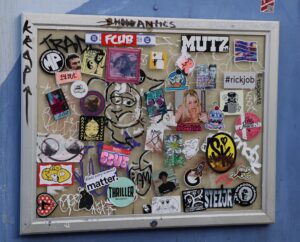Video interviews inherently have multiple points of exclusion in their design.
Points of Exclusion
The two primary aspects of my final deliverables for this project are audio and video. Both of these components inherently have points of excursion: video relies on eyesight, and audio relies on hearing capabilities.
Because motion pictures are entirely visual, they do not match the needs of those who are not capable of seeing well, even if it’s just temporary.
Additionally, the audio element of my final deliverables do not match the needs of those who are not able to hear. This decreases the accessibility of my project most importantly for those who are deaf or hard of hearing, but also even just people who don’t have access to audio at a given time.
Not to mention, in order to even access my final deliverables a person will need an internet connection along with some sort of technology to play the video with audio.
Access Design Solutions
I plan to implement a few strategies in effort to be more inclusive in the design of my final deliverables for this project.
Probably most importantly, I will be sure to feature proper and easily legible closed captioning. Rather than relying on the sometimes faulty caption-generating technology, I will manually ensure that there is a fully accurate transcript for captioning of each interview. I will also do this for any instagram posts. Not only does this allow for more accessibility for those who are hard of hearing, but also benefits people who just prefer to read captions as they watch, and people who may not be able to play audio out loud.
I will also make sure that the visuals in my videos are of high enough contrast to be easily legible. Especially for things like captions, graphics and titles, I will use color combinations with high contrast to make them easily distinguishable from one another. I thought when it was mentioned in the Microsoft Inclusive Design Toolkit that high contrast screen settings were originally an effort to increase accessibility for people with vision impairments, but also ended up benefiting anyone looking at a screen in sunlight.
Another way to increase accessibility for all people in the design of my project is to create media alternative transcripts, or audio transcriptions that detail the entirety of each video (kind of like an out-loud screenplay). Interviews are obviously already covered by audio, but audio descriptions of any B roll and titles that only appear visually. This would allow for people to have descriptions read to them (like alt text), and would not require visuals.
Distributing/Promoting My Project
One way I plan on promoting this project is through stickers that have a QR code to my YouTube channel. Making and placing stickers is common practice for promotion in the graffiti community. Using the medium of stickers to get word out about my project not only aligns with the street art and graffiti ethos, it also would be the most effective way to reach the graffiti community. If I place stickers in spots that have other stickers in the city, graffiti artists and fans would be most likely to notice them since they place stickers themselves, and actually look for and read other stickers.

Plastic sign covered in stickers by graffiti and street artists’ stickers on South Street, an example location of where I’d place a promo sticker
I also plan to promote this video series through an instagram account. Since becoming interested in graffiti, I’ve been posting photos of graffiti I like to an account called graffiti.in.philly (that’s how I got participants). It doesn’t have a ton of followers, but all of the followers are interested or partake in Philly graffiti, which is a positive. I plan to create instagram reels with clips from interviews, and ask the artist participants to repost them.
I will likely promote this video series on my personal instagram account since I want to reach as many people as possible. I will also be listing this video series on my personal website. While this is a platform mostly meant for possible employers and clients, I have the URL linked to my email and social media accounts, which may give it some more attention.
Leave a Reply